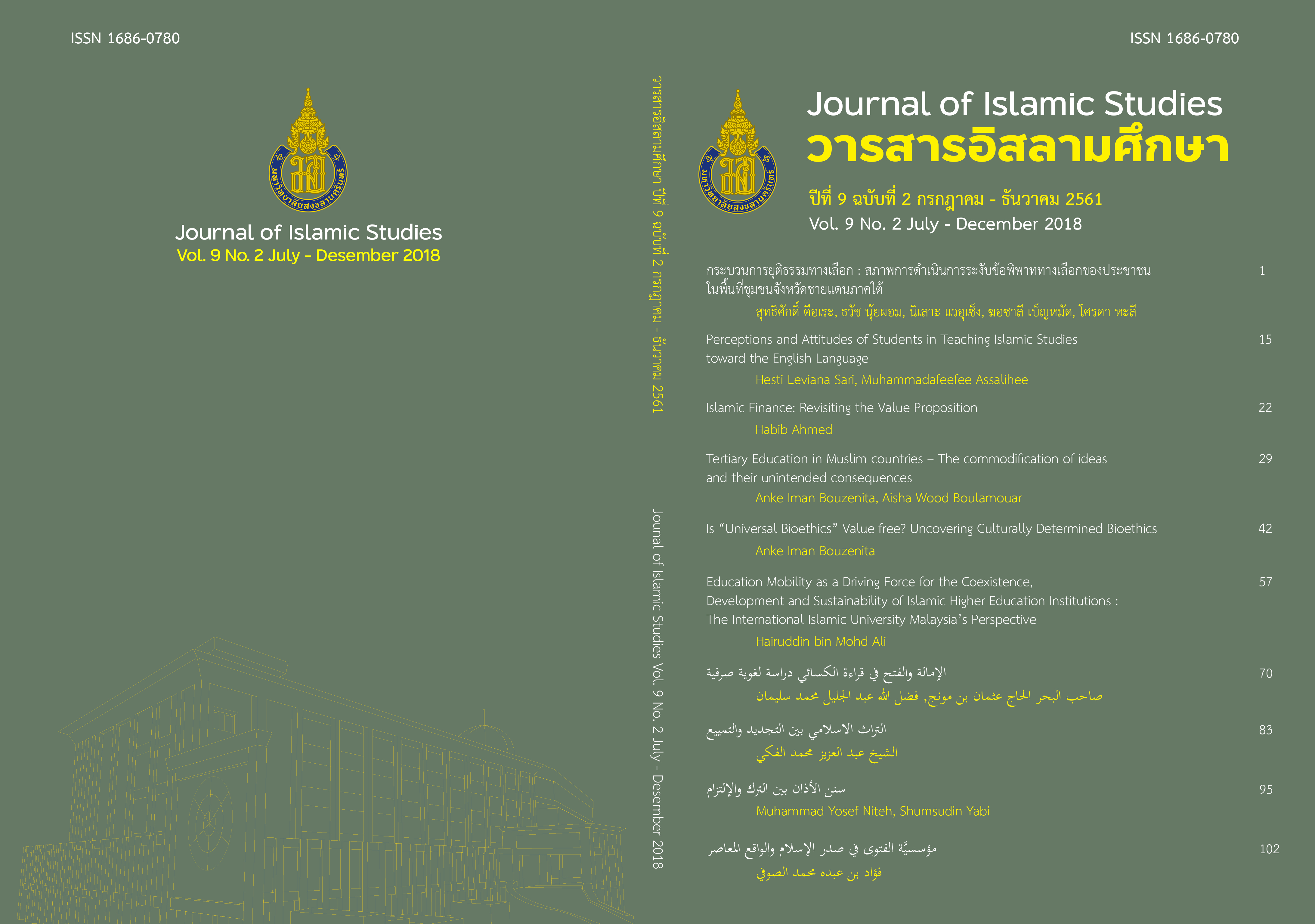Education Mobility as a Driving Force for the Coexistence, Development and Sustainability of Islamic Higher Education Institutions: The International Islamic University Malaysia’s Perspective
คำสำคัญ:
Global Prominence, Internationalization, Education Mobility, Strategic Management, International Islamic University Malaysiaบทคัดย่อ
Global Prominence (eighth shift), comprising internationalization and education mobility, is considered as one of the supreme key result areas (KRAs) in the Malaysian Education Blueprint 2015-2025 goals. This paper focuses on and discusses Education Mobility as one of the KRAs that will generate a driving force for the coexistence, development and sustainability for higher education institutions in 2020s from an academic perspective. The discussion starts with the introduction of several education management related theories such as educational strategic management theories, education internationalization theories, education mobility theories, education development theories and higher education institutions sustainability theories. Next, the paper introduces and discusses the application of those theories in International Islamic University Malaysia (IIUM) long term strategic planning. The paper ends with suggestions and recommendations for improvement of IIUM’s strategic planning effective implementation.
เอกสารอ้างอิง
Abdul Rahman Ahmad, Alan, F., Moonsamy, N. (2012). An examination of the implementation federal government strategic plans in Malaysian public universities, International Journal of Business and Social Science, Vol. 3, (15), pp. 290-301.
Asim, M. (2001). Adopting Quality Management Concepts in Public Service Reforms: The case of Malaysian Public service, Labour and Management in Development Journal, Vol. 2, No. 6, ANU: Asia Pacific Press.
Bolt, J.F. (1996). Developing Three Dimensional Leaders: In Leader of the Future, In Frances Haselbein, Marshall Goldsmith, and Richard Beckhard (Eds) 161-174, San Farncisco: Jossey Bass.
Boal, K.B. and Hojberg, R. (2000). Strategic Leadership Research. Moving On, Leadership Quarterly, 11, 515-549.
Covey, S.R. (1996). Three roles of the leader in the new paradigm, In Hasselbein, F., Goldsmith, M., and Beckhard, R. (eds). The Leader of the Future: New Visions, Strategies and Practices, for the Next Era, San Francisco: Jossey Bass.
Davies, B. and Ellison, L. (2003). The new strategic direction and the development of the schools: Key Frameworks for school improvement planning, New York: Routledge Falmer.
Davies, B. and Davies, B.J. (2009). Strategic Leadership, In Davies, B. (Ed.), The Essentials of School Leadership, (2nd Edn.)Thousand Oaks, CA: sage Publications pp. 13-35.
Elmore, R.F. (2002). Unwarranted intrusion, Education Next, 2(1) 30-35.
Erwin, D.G. and Garman, A.N. (2010). Resistance to organizational change: Linking research and practice, Leadership and Organizational Development Journal, Vol. 31, No. 1, p 39-56.
Groundwater-Smith, S. (2000). Evidence-Based Practice-Towards Whole School Improvement. Paper presented in the Annual Conference Australian Association for Research in Education Sydney, 4-7 December, 2000.
Gouldner, Alvin W. (1957). “Cosmopolitans and Locals: Toward an Analysis of Latent Social Roles-I.” Administrative Science Quarterly 2: 281–303.
Hoy, W. and Miskel, C. (1991). Educational Administration. Theory, Research and Practice., New York: McGraw Hill
Hackman, M. and Johnson, C. (1991). Leadership. Prospects Heights: Waveland Press.
Hal, B. and Thompson, H. (1980). Leadership through Values. Ramsey, New Jersey: Paulist Press
Inas Zulkipli, (2016). The Vocational College Leaders’ strategic Leadership Practices, Organizational Bureaucracy and I-Service Training as Determinants for Students’
Aspiration Outcomes., Unpublished PhD Thesis, IIUM, 2016.
Lasisi, Abass Ayodele (2016). The Effects of Organizational Quality Management Initiatives and Mediating Factor on the sustainability of Malaysian Higher Education Institutions, Unpublished PhD Thesis, IIUM, 2016.
Moore. J. (2005). Seven recommendations for creating sustainability education at the university level: a guide for change agents, International Journal for Sustainability in Higher Education, Vol. 6 (4)p. 326.
Nur Anisah, A. (2012). Performance measurement in Malaysia’s Higher education, PMA 2012 Conference, Cambridge UK 11(13) p. 1-10.
Quong, T. and Walker, A. (2010). Seven Principles of Strategic Leadership. International Studies and Education Administration (ISEA), 38(1).
Ramsey, R. (2003). From A-Z: Practical Lessons from Successful Schools Businesses, Thousand Oaks, CA: Corwin Press.
Robinson, V. (2007). How school leaders make a difference to their Students. Keynote address to International Confederation of Principals, a paper presented to the 2007 International Confederation of Principals, Auckland, 2nd April, 2007.
Rumane, A.R. (2011). Quality Management in Construction Projects, New York: Taylor and Francis Group.
Sadler. P. (2003). “Strategic Management” MBA Masterclass (2nd Ed.). UK: Kogan Page.
Soler, Manuel. (2001). “How Inbreeding Affects Productivity in Europe.” Nature 411: 132.
Wright. T. (2010). University presidents’ conceptualizations of sustainability in in higher education, International Journal of Sustainability, in Higher Education, Vol. 11, No.
1, p. 61-73.
Zainal Abidin, M., Ann, H.J. and Yee, W.F. (2010). Strategic Management, KL: Oxford Fajar
ดาวน์โหลด
เผยแพร่แล้ว
รูปแบบการอ้างอิง
ฉบับ
ประเภทบทความ
สัญญาอนุญาต
บทความทุกเรื่อง ที่ได้รับการตีพิมพ์ในวารสารอิสลามศึกษาเป็นแนวคิดของผู้เขียน มิใช่เป็นความคิดเห็นคณะผู้จัดทำและมิใช่ความรับผิดชอบของคณะวิทยาการอิสลาม กองบรรณาธิการไม่สงวนสิทธิ์การคัดลอก แต่ให้มีการอ้างอิงแสดงที่มา




